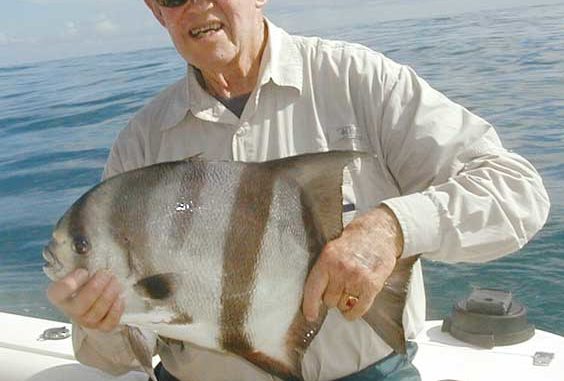
Spadefish provide a consistent, fun — and cheap — alternative to summer fishing doldrums.
In 1970 Lee Parsons kept seeing big striped, flat-sided fish at the wrecks and reefs off Wrightsville Beach.They looked like they’d be fun to catch, but nobody had figured out how to get them to bite baits or lures. They wouldn’t take plastics and showed no interest in live bait. Cut baits, such as mullet, they ignored.
“I first saw them at WR-4,” said Parsons, who has been a licensed guide (Gottafly Guide Service, 910-540-2464, www.gottaflyguideservice.com, gottaflylee@ec.rr.com) for the last 12 years.
WR-4 is the wreck of the John D. Gill, a merchant vessel sunk by a German submarine in 1942, 25 miles south-southeast of Masonboro Inlet in 90 feet of water.
“It took me a long time to figure out how to get a spadefish without using a spear gun,” Parsons said. “If I hadn’t used the gun in the early days, I’d have starved back then.”
Spadefish average 18 to 36 inches in length and can weigh up to 16 pounds with N.C. average sizes 3 to 6 pounds. They eat algae, sponges, polychaete worms and a variety of plankton animals. So it’s no wonder Parsons had trouble figuring out which bait to put on a hook to entice them.
A dedicated diver in his spare time — when he wasn’t a marine biology student at Cape Fear Technical College or working as a master carpenter who installed staircases and mantels in more than 1,000 homes in the Wilmington area — Parsons marveled at the vast (and unexpectedly flourishing) community of tropical fish, including American spadefish, that lived at the reefs offshore from Wilmington.
“The live bottoms offshore are where everything lives,” he said. “There are grasses and corals that provide places where little fish hide and big fish that eat them places to hide and ambush the little fishes.
“Few people know that Wilmington once was the lobster capital of the eastern U.S., not Maine or Massachusetts, because the reefs had plenty of spiny langustas (lobsters),” he said. “Also out there, you can see yellowtail snapper, squirrel fish (they look like a red drum with big eyes but have poisonous spines), rainbow runners, lionfish, even bonefish and permits.”
Spadefish are present at local waters all the time, contrary to what many people believe.
“The best times to catch them are July and August, and that may be because more people are on the water,” said Parsons, a noted fly-fishing guide and sailfish angler (he’s won the Eddie Haneman Sailfish tournament, N.C.’s only such event, a couple of times). “But spadefish seem to school better during warm weather.
“If you want to catch them in June, for instance, you need to go offshore about 10 miles; they won’t be close to inshore places in June. But they’re closer and in good numbers in July and August, when the water temperature reaches 80 degrees. And they’ll be there through November.
“In fact, I’ve found I catch them really good in November, when the water’s cool. It’s just that they don’t get thick anywhere until July, then they stay thick until November.”
The only problem with fishing for spadefish during November, when the water temperature may dip into the 60s, is finding the proper bait. And that leads back to Parsons’ earliest attempts to figure out what they’d eat so he could use it as bait.
“I read where (anglers) up north used clams to catch them, especially in November, so I tried that for a while,” he said. “But (using clams) is pretty expensive. You have to use chowder clams in winter when there aren’t any jellyfish.”
He finally discovered by reading that spadefish will eat jellyfish. The main bait he uses for spadefish are what the locals call “jellyballs” or “cabbageheads” and the good news is they’re plentiful.
Anyone who has taken a North Carolina beach vacation has seen jellyballs washed up at the shoreline. They’re round, clear-looking creatures, about the size of a softball, and look as if they’re made of rubbery plastic but don’t have stinging tentacles.
Parsons said jellyballs float off Wrightsville’s beaches until October, which is good because they offer a free supply of spadefish bait.
Parsons uses his rubberized landing net to scoop up floating jelly balls. A good spot to find them is at the end of the Masonboro Inlet jetties. Parsons places the jellyballs in two 5-gallon buckets and fills them with water to keep them fresh. During the day, he periodically refreshes the cabbageheads with water from a hose.
One of the nice aspects of spadefishing these days is they’re found relatively close at inshore reefs and wrecks — which means less fuel ($4.54 per gallon for diesel during June) needs to be purchased and burned.
Parsons’ favorite places to fish for spades with the Gottafly, his Boston Whaler Outrage powered by a 225-horsepower Mercury outboard, include the Liberty Ship/Meares Harris Reef (AR 370, 3.5 miles from the Masonboro Inlet sea buoy), the 5-Mile Boxcars (AR 372, 5 miles from the sea buoy), the 7-mile ledge, 10-mile Boxcars (AR 376, 9.9 miles from the sea buoy), the Dredge Wreck (AR 382, 10.2 miles from the buoy) and Schoolhouse Wreck (AR 376, 17.8 miles from the inlet).
“All these places will have spadefish in July and August,” he said.
Once he motors to a reef (he begins closest to shore at the Liberty Ship), Parsons finds an upwind spot, drops anchor and ties his anchor line to a bow cleat. He’s so expert that his “scope” (amount of anchor line) usually stops the boat’s drift directly above a chosen reef or wreck.
Then Parsons dons a pair of rubber gloves.
“This is the only part of spadefishing I don’t like,” he said. “See that?”
He pointed to a reddish-stain that dripped off a jellyball he’d picked up.
“That stain will get on our boat, your hands, your clothes, and it won’t come off without some hard scrubbing,” he said. “Jellyballs look clear, but that stain gets on you when you handle them.”
Parsons had doubled and twisted a piece of No. 16 wire to make about a 4-foot-long jellyball “teaser” rig. He twisted two heavy lead weights onto the wire tags at one end (the other end had a loop for tying on a piece of 100-pound-test monofilament).
Parsons then pulled out a fillet knife, picked up a jellyball and punched a hole in the center of its smooth head. He pushed the wire with the loop on the end through the jellyball, repeating the task until four round, clear jellyballs were suspended on the wire. Then he tied one end of 100-pound-test mono to the loop and lowered the ball beside the boat about 40-feet deep into the ocean. Then he secured the mono line around a rod-holder.
“I’ll cut up some other jellyballs and toss ’em over the side to act as chum,” he said. “That should draw the spadefish from the wreck. Then they’ll see the teaser rig and start pecking at it. We also can use the cut jellyballs for bait.”
Once spadefish discover the teaser jellies, they’ll peck at the jellyfish.
“You put your hand on the mono and lift up enough to bring the line tight, and you can feel ’em hitting it,” Parsons said. “That’s when you bring it slowly to the top. When the water’s clear, you can see the fish way down there.”
Once fish are near the surface, Parsons again ties off the jellyball teaser line, then casts pieces of cut-up jellyball toward the feeding fish.
It usually takes just seconds for a hit to occur, because Parsons will have first cut up an entire jellyball into three-finger wide-and-long size chunks and tossed them over the side.
As the chummed jellyball pieces sink, spadefish will flash through the water and grab the chunks. Their quick movements and striped bodies are easy to spot.
Fishing for spadefish at the surface is done by tying a small treble hook onto a 3-foot piece of fluorocarbon leader, then hooking the treble into a jellyball piece and casting it toward visible fish.
Parsons uses 20-pound braided line and 12-pound-test fluorocarbon leader and spinning equipment.
“You just let the bait sink in the water,” he said. “By using a treble, the spadefish will hook himself. All you have to do is hold on.”
Because spadefish are flat-sided creatures, they can put up a terrific fight on light tackle.
“They pull like a 5-gallon bucket,” Parsons said.
However, sometimes spadefish won’t come to the surface because of predatory fish, such as sharks and barracudas. But even if they’re not visible, that doesn’t necessarily means spadefish are absent at a wreck or reef. And there’s a way to catch them in that case.
“’Cudas do eat spadefish,” said Brian Carroll, a South Carolina photographer and angler. “Everytime I get one on a hook, I think they’re actually running from a barracuda.
“At Capers Reef near Charleston, the ’cudas sit on the surface and watch us. When we hook up, they come running and start getting frantic. Often we’ll lose half of (a spadefish) to a ’cuda.
“The ’cudas are (at a wreck or reef) because the spades are there. If you see them them on the depth-finder, that’s a dead giveaway. Look at your depth-finder while you’re on top of structure, then drop a jelly down on a Carolina rig.
“We usually just sit them in rod-holders about 5 feet to 10 feet off the bottom, and the rod will just double over. The spadefish hook themselves.”
Carroll likes a Carolina rig with 1-ounce weights and 16-inches of 30-pound-test leader when he fishes deep for spadefish.
“We loaded the cooler one day without even seeing a spade (on the surface),” he said. “We had a wind chop, but we anchored above the caisson at Capers Reef and dropped (jellyball pieces) down on that same rig.
“They’ll eat anytime. You just have to get the jelly in front of them.”
Parsons uses 6-foot St. Croix spinning rods with Penn 360 Slammer reels.
“If I want to catch and release (spadefish), I use No. 2 Mosquito J-hooks and sometimes I bend down the barbs,” Parsons said.
The 56-year-old Parsons said he often uses his knowledge of the changing bottoms off Wrightsville Beach to help him determine where to fish. His diving experiences help in that respect as well.
“It helped me understand how the bottom changes and helps me find fish,” he said. “Sometimes you’ll have hard bottom — which is where you’ll find fish — and a hurricane might come in and cover the bottom with sand. In that case, you lose a hot spot (for catching fish). Then you go back and check two or three years later, and a nor’easter will have uncovered the hard bottom and it’ll be a hot spot again.”
Another pleasing aspect about spadefishing is when other bites slow in summer, these fish will hit as long as anglers toss chunks of jellyballs at them.
“You haven’t really spadefished until you’ve seen 200 or so behind you boat,” Parsons said. “Then it’s just a matter of catching fish until your arms give out.”

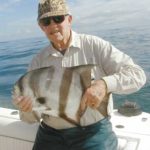

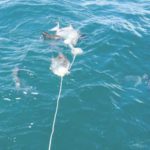
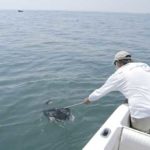
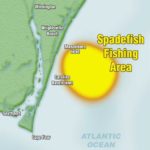



Be the first to comment